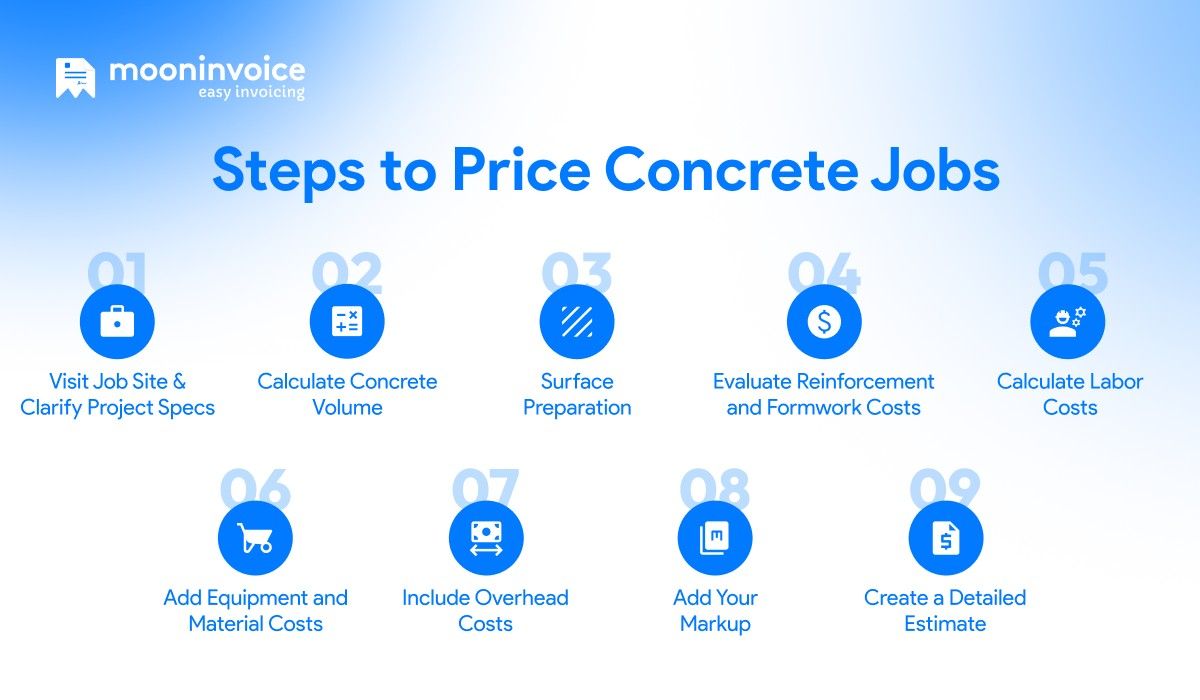As a contractor, if you know how to price concrete jobs, you are on the right path to establishing a successful business. But what does it mean when we say we know the pricing for concrete jobs? Is it about knowing the price per yard? Not entirely!
Multiple factors affect the price of a concrete job. The common pricing factors are surface preparation, reinforcement, materials used, labor, formwork, and finishing work.
Plus, keep in mind that pricing can vary by job type and location. When you know which job should cost how much, you will most likely stay profitable in the long run.
In this blog, we will explore in detail how much does a concrete contractor charge, the steps on how to charge for concrete work, and other pricing factors.
So, let’s jump straight into the topic…
📌 Key Takeaways
- To price concrete jobs accurately, you must calculate them phase by phase, including labor and overhead costs.
- Before preparing an estimate, it is necessary to visit the site and clarify project specifications to avoid surprises later.
- Calculating the concrete volume and surface preparation remains the top priority before creating an estimate.
- You need to evaluate reinforcement, formwork, and labor costs for the concrete work.
- Next, you need to sum up all costs and add a markup to ensure a good profit margin.
Why is Accurate Concrete Pricing Necessary?
You must use accurate pricing to keep your business profitable. It is more than just quoting a number. When you calculate estimates in detail, you will have complete control of your budget. Accurate pricing helps you protect your margins in case of unexpected expenses or disputes.
When your pricing standards are not up to par, it can lead to losses, cash flow issues, and poor credibility. Not to forget, concrete projects come with inconsistent material costs and site complexities. If your pricing is inaccurate, it can significantly affect total expenses.
When you price accurately, you are more likely to grow into a successful contractor. Now that we understand why accurate concrete pricing is necessary, let’s walk through how you can price your concrete jobs step by step.
9 Easy Steps to Price Concrete Jobs

If you think finding the answer to “how to price concrete jobs?” is going to be challenging, you are wrong. Here is a simplified step-by-step process you should follow:
1. Visit Job Site & Clarify Project Specs
To clearly solidify your concrete estimate, you must visit the site first. Preparing an estimate without visiting the site is one of the biggest reasons why the cost cap exceeds, and leads to arguments later. Consider this step as both fact-finding and risk management. Here, you will gather data that will be later converted into quantities, hours, logistics plans, and prices.
The primary goal of a site visit is to ensure the dimensions shown on drawings are correct. Plus, a site visit allows you to have a more practical view of approaching the project. You can identify hidden costs and unknown risks that can go unnoticed in paper drafts.
Here’s what you need to inspect and record during the site visit:
- Measurements & Geometry
- Subgrade & Soil Conditions
- Existing Structures & Utilities
- Access & Logistics
- Equipment Needs & Limitations
- Environmental Changes
Inspecting the above will ensure a positive outcome of your project.
Paper-based Concrete Estimates Slowing Down Your Growth?
Easily create concrete estimates with the help of free estimate templates to acquire more concrete jobs.
2. Calculate Concrete Volume
After completing the site visit, the next step is to calculate the concrete volume and consider surface preparation needs before pouring. This step is necessary because there is no such thing as “small mistakes” in concrete work. One simple mistake or an ignored part can lead to a material shortage or additional costs. Before calculating the price of concrete per square foot, you need to calculate the concrete volume.
To calculate concrete volume, use the formula below:
First, measure the length, width, and depth of the area. Then use the standard volume formula:
- Volume = length x width x depth
Using this formula, you will get your concrete volume in cubic feet. But if you need volume in cubic yards, you can divide volume by 27, i.e,
- Cubic Yards = cubic feet / 27
Don’t forget to add a waste factor like 5-10%. Completely relying on math might not work in some cases. While pouring, there may be spillage, errors, or odd fittings at the edges. So it is always good to have a waste factor, which makes it easier to operate.
💡DID YOU KNOW?
According to an article on ConcreteNetwork.com, the nationwide average concrete price was $166.39 per cubic yard in the first half of 2024.
3. Surface Preparation
Once you are done with the concrete volume calculation, prepare the surface. In concrete work, before pouring your cement-sand-water, the area needs to be cleaned well, which may require demolition (to align the ground properly). This is why it is important to consider surface preparation costs. Ignoring this might hurt your profit margins.
Below are some of the surface preparation costs associated with concrete work:
- Demolition: Does your concrete work require the old foundation to be torn out? It could be anything, like a broken window or cracked patio. Then it’s time to dump, calculate machine hours, and every cost.
- Ground Aligning: A sloped ground is not ideal for concrete. You have to align 90 degrees, and then you can start your work. So, if it adds cutting and reshaping, you must add these costs.
- Debris Removal: If broken or unfinished concrete waste is present on the surface and needs to be removed, this adds to the total cost.
4. Evaluate Reinforcement and Formwork Costs
Reinforcement and framework development are two of the most difficult parts of a concrete project. They play a major role in assuring the stability, lifespan, and load-handling capacity of the completed project. Calculating these costs means you are not underestimating labor, materials, and installation time, which can impact the final concrete pouring cost.
Concrete is strong in compression but weak in tension. This is the primary reason structural concrete projects require reinforcement.
While evaluating reinforcement and formwork, ask yourself:
- Does your project require rebar (steel reinforcement) to support the pillars?
- Do you need welded wire mesh for the project?
- Do you need a slab with a 6-inch thickened edge/footing?
Rebar prices in the U.S. range from $0.30 to $0.50 per linear foot, whereas wire mesh costs $0.15 to $0.30 per square foot.
On the other hand, formwork (the molds used to shape concrete) costs $2 to $3 per linear foot for a basic sidewalk-type project. But for larger concrete projects, the formwork cost ranges from $2.50 to $6 per square foot.
5. Calculate Labor Costs
Labor cost is the most variable expense in a concrete project. It fluctuates based on the skill level, job requirement, site conditions, project deadlines, etc. So, calculating labor costs is key to completing the job on schedule and protecting profit margins.
Here is how to calculate labor costs.
First, list every labor role involved in the project. It can include:
- Equipment operators (skid-steer, excavator, pump operator)
- Rebar installers
- Skilled laborers
- Pour day specialists
- Concrete finish workers
- Cleanup laborers
Each laborer, as mentioned above, has a different hourly rate. Separately calculating the cost makes the estimate more accurate.
Next, calculate cost burdens with the hourly rate.
Suppose you are charging $35/hour per worker without calculating the cost burdens, you could be losing money without knowing it. When you calculate base wage, payroll taxes, workers’ compensation, and insurance, only then will you get to know the true hourly rate per worker.
You might be paying $35 to a worker whose true value should be $27.
Don’t forget overtime and delays. Workers who work overtime must receive overtime pay, whereas delays should incur a penalty.
After doing all these, you can calculate the labor cost for your concrete jobs using the formula:
- Labor Cost = crew size x hourly rate with burden x estimated hours
Below is an example of how the labor cost should be calculated for concrete jobs:
| Phase | Crew Size | Estimated Hours | Hourly Rate with Burden | Total Labor Cost |
|---|---|---|---|---|
So, the total labor cost for the concrete job of the given example will be $1,740. (Sum of all labor costs)
6. Add Equipment and Material Costs
In concrete work, we can say that material cost covers a large portion of the total concrete expenses. Material cost needs to be correctly checked and calculated, as it keeps your estimate realistic. This step falls right behind everything you have calculated so far, i.e., concrete volume, surface prep, reinforcement, and labor cost.
So, how will you calculate material cost for concrete jobs? Let’s find out.
First, list the equipment needed for each job. For example, if you are batching small loads onsite, you will require mixers. But for larger flatwork, power trowels and floats will be required.
Below are the common equipment needs to complete concrete work:
- Concrete mixers
- Screeds
- Excavators
- Mini backhoes
- Concrete pumps
- Rollers or compactors
- Bull floats and trowel machines
Some contractors have their own equipment, while others rent it. Independent contractors who own equipment need to list out the maintenance and operational costs. Contractors who rent equipment should focus on evaluating the daily cost and the minimum hourly cost.
7. Include Overhead Costs
Overhead costs are the silent killers in concrete projects. They are easy to overlook and affect profit margins heavily if left unchecked. A step-by-step, concrete construction estimating process never misses out on overhead because it represents all the indirect expenses.
This is the cost you pay to sustain your business and is not relevant to the task on the job site. The most common overhead costs in a concrete business may include:
- Office rent
- Business equipment (tablets, computers, cell phones)
- Licensing and certification
- Vehicle expenses (fuel, maintenance, registration)
- Marketing and advertising
- Estimating software
- Admin office salaries
Overhead cost needs to be accurate, as an unnecessary price hike could impact client acquisition. Break down your overhead cost in hours. Here’s how to do it:
- Hourly overhead cost = monthly overhead cost / billable hours per month
Let’s assume your concrete business overhead cost in a month is $5000, and your billable hours per month on average are 300, then the hourly overhead cost will be:
- $5000 / 300 = $16.66/hour
This overhead cost needs to be included in the estimate you will share with your client.
💡Also read:
8. Add Your Markup
Markup is the money you will count as your profit. Adding markup price is one of the most important parts of the entire pricing process. You have completed your calculations for labor, materials, equipment, and overhead. Now is the time to turn those numbers into a profitable selling price.
Some business owners don’t add markup because they fear losing projects, but the reality is that without a profit margin, you are working hard just to sustain, not grow!
To add markup, first you need to calculate the total cost of the concrete work.
- Total cost = labor + material cost + overhead + cost of concrete needed
Now, suppose you are adding 20% profit margin, the total markup price will be:
- Final price = Total cost / (1 – profit margin)
For example, if your total cost for a concrete job is $25,000 and you add a 20% profit margin, the final price will be:
- Final price = $25,000 / (1 – 0.2) = $25,000 / 0.8 = $31,250
You should charge a markup of $6,250 on top of your cost of $25,000 to attain a 20% profit margin.
Not sure how to calculate your markup? Use the online markup calculator for free!
9. Create a Detailed Estimate
Once all your calculations are complete, you can proceed to create and send an estimate to the potential customer. To ensure a seamless finance workflow, you should use tools such as an estimate generator for your concrete business.
Here’s how you should create a detailed estimate:
- Select an estimate generator or estimating software
- Put your business name and logo
- Add your business contact information
- Add customer details such as name, address, and contact info
- Include a unique estimate number (similar to invoice and PO numbers)
- List out all services you are going to provide, with quantity and price
- Clearly define additional notes or terms & conditions
- Sum up all costs and add the total cost to be paid (with taxes)
Generally, estimating software is preferred over paper-based estimates because it offers features such as free estimate templates and saves a lot of time.
Common Mistakes to Avoid When Pricing Concrete Jobs
While pricing concrete jobs, many contractors make mistakes and learn over time. But here are some mistakes to avoid at all costs, or you may face lower profit margins.
- Not prioritizing site preparation: Overlooking soil testing or slope areas may lead to cost overruns later.
- Miscalculation in material quantities: A simple calculation error can make you re-work from the start.
- Skipping overhead costs: Omitting overhead costs reduces profit margins and limits growth.
- Not specifying the work type: Some contractors assign a single specialized laborer to multiple phases of concrete work, increasing the risk of failure.
Is a Concrete Business Profitable in the Long Run?
There is no doubt that concrete business is going to be profitable in the long run. The demand for construction work and concrete services is increasing as the modern world moves away from traditional foundations. As a contractor, the profitability of your concrete business depends on how accurately you price jobs, manage labor, and maintain vendor relationships.
If you follow the step-by-step process mentioned above, the whole pricing process is likely to improve. But just pricing accurately won’t solve your financial intricacies. You should consider using software that allows you to create estimates, invoices, and reports in a single platform.
One such example is Moon Invoice. Start your free trial today!




















